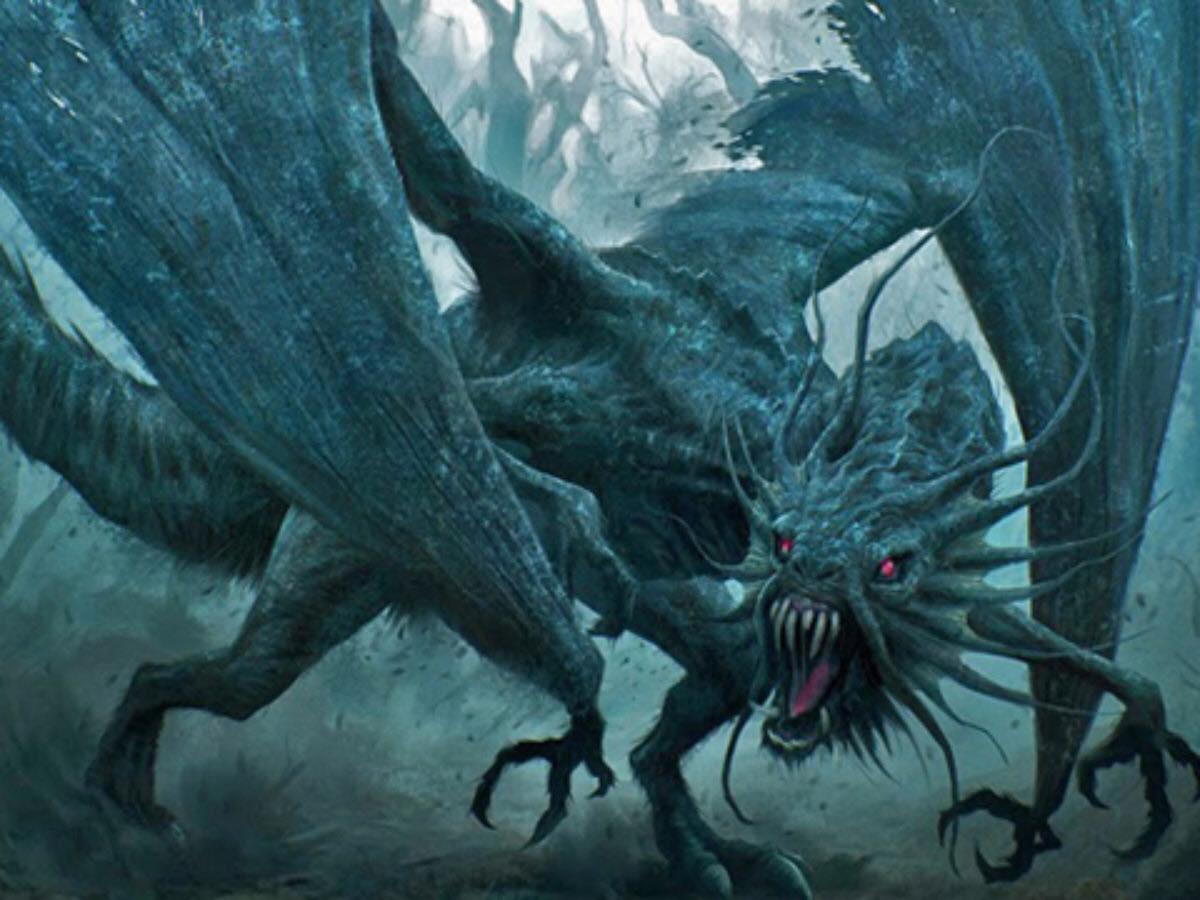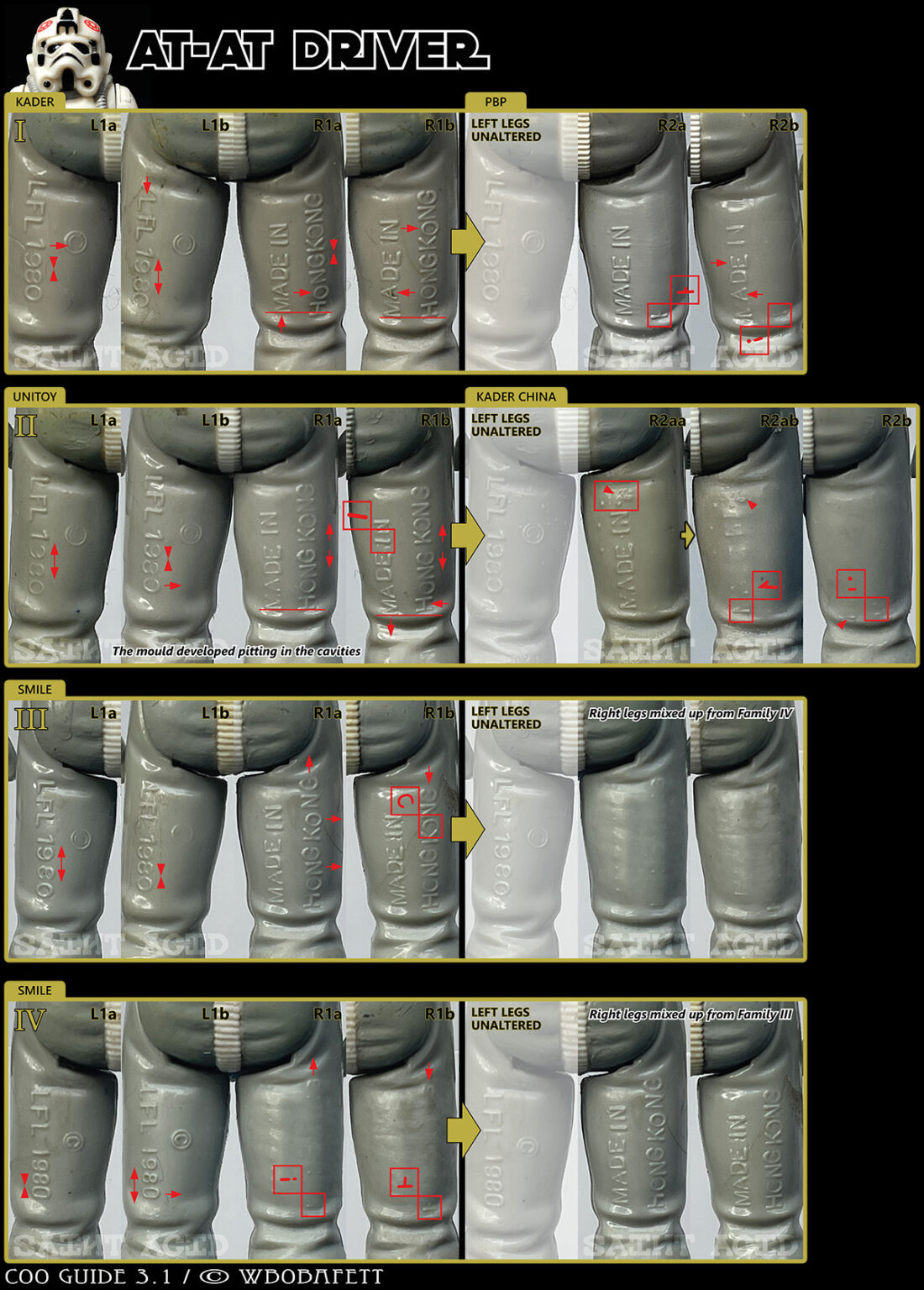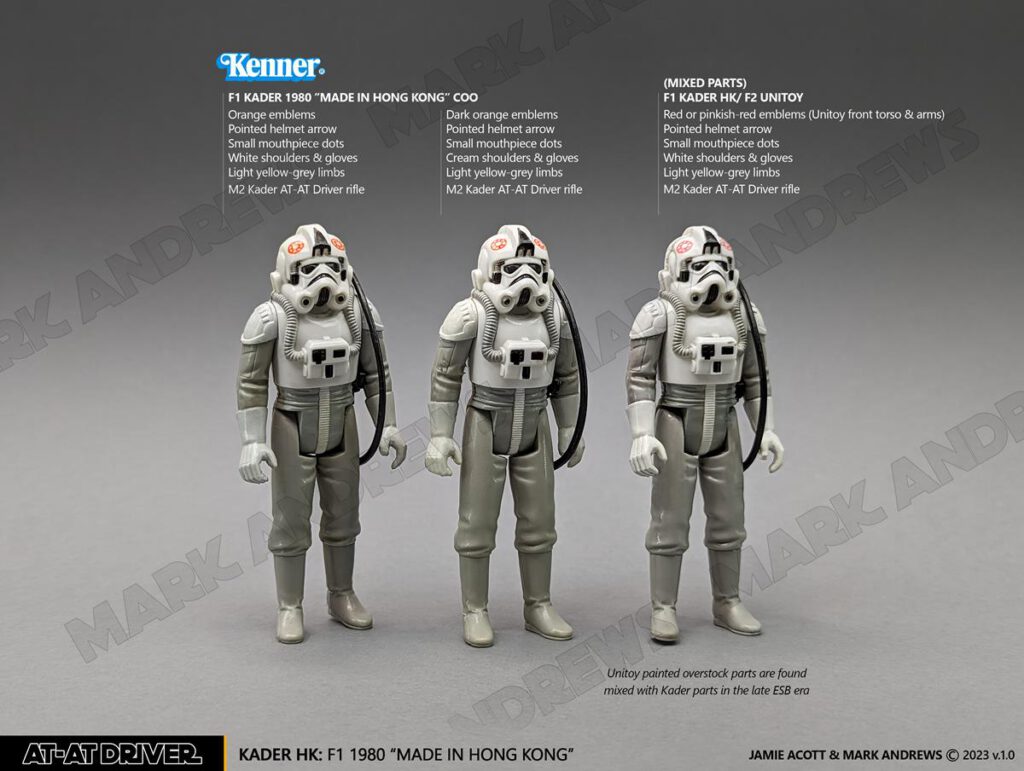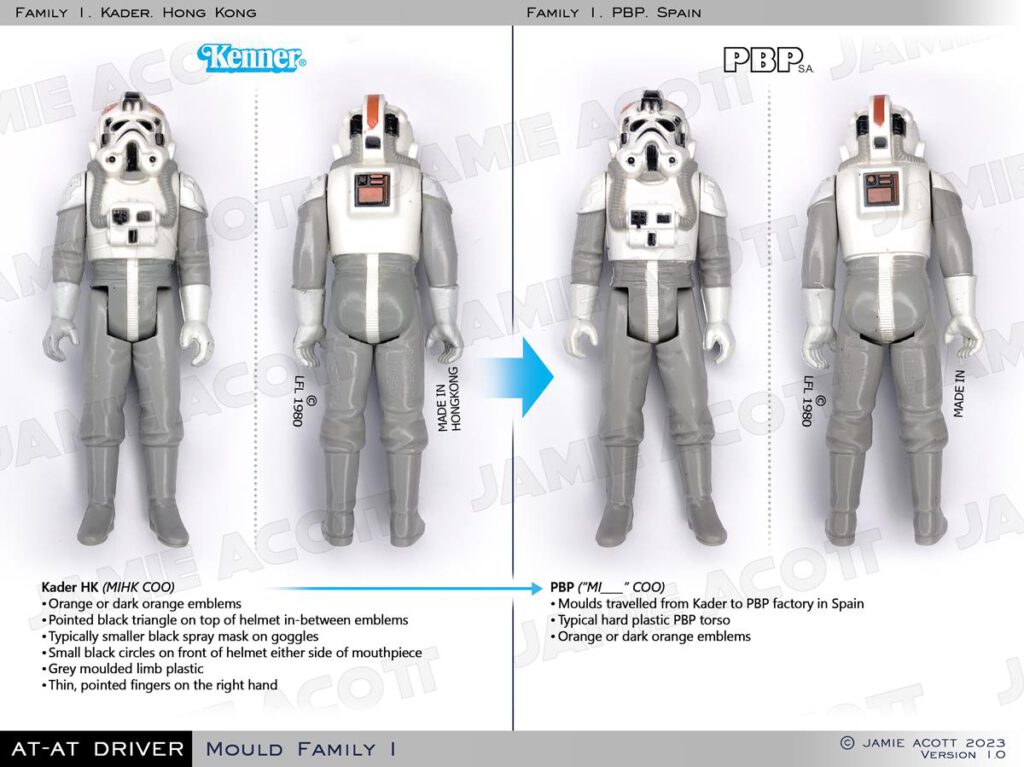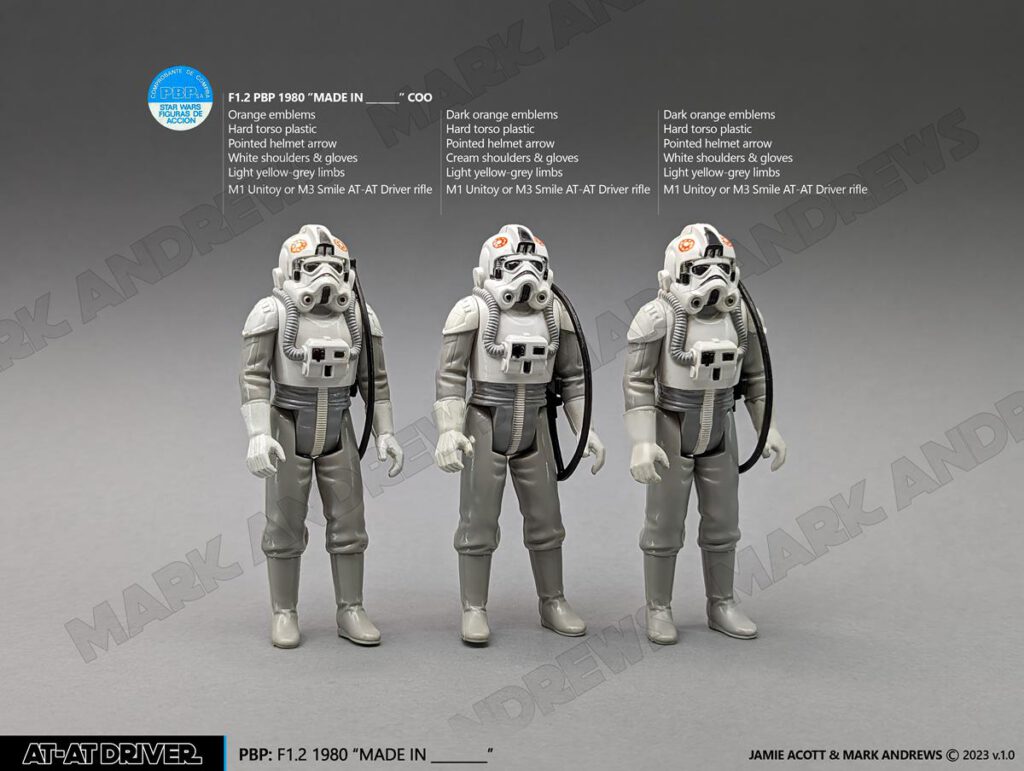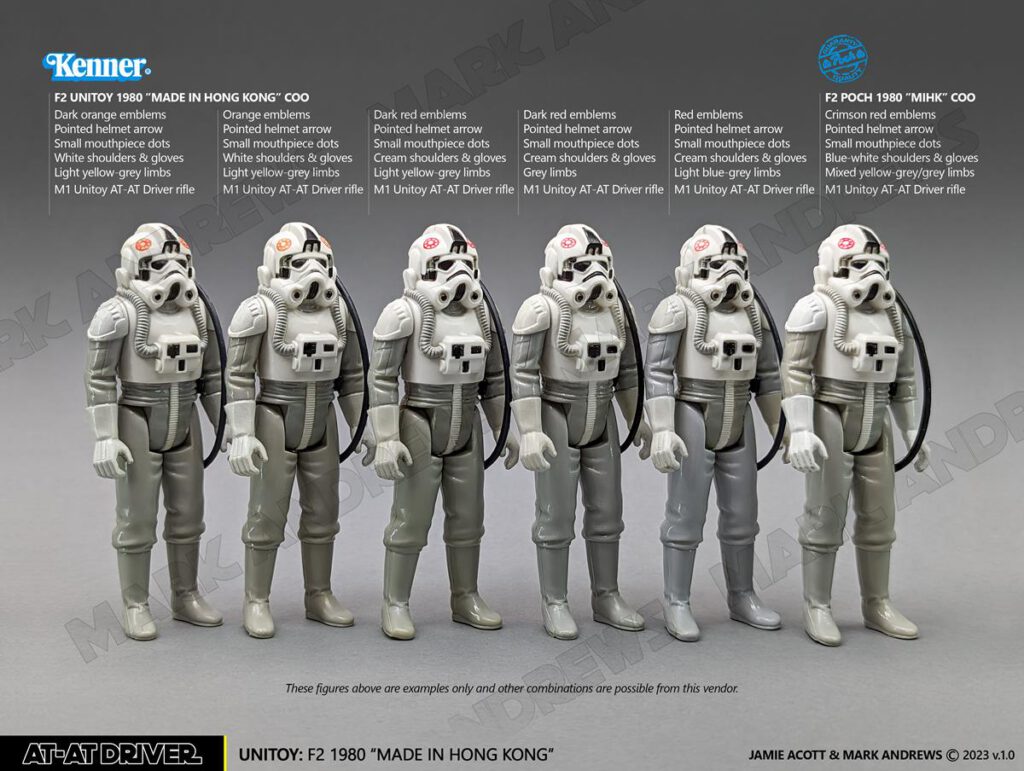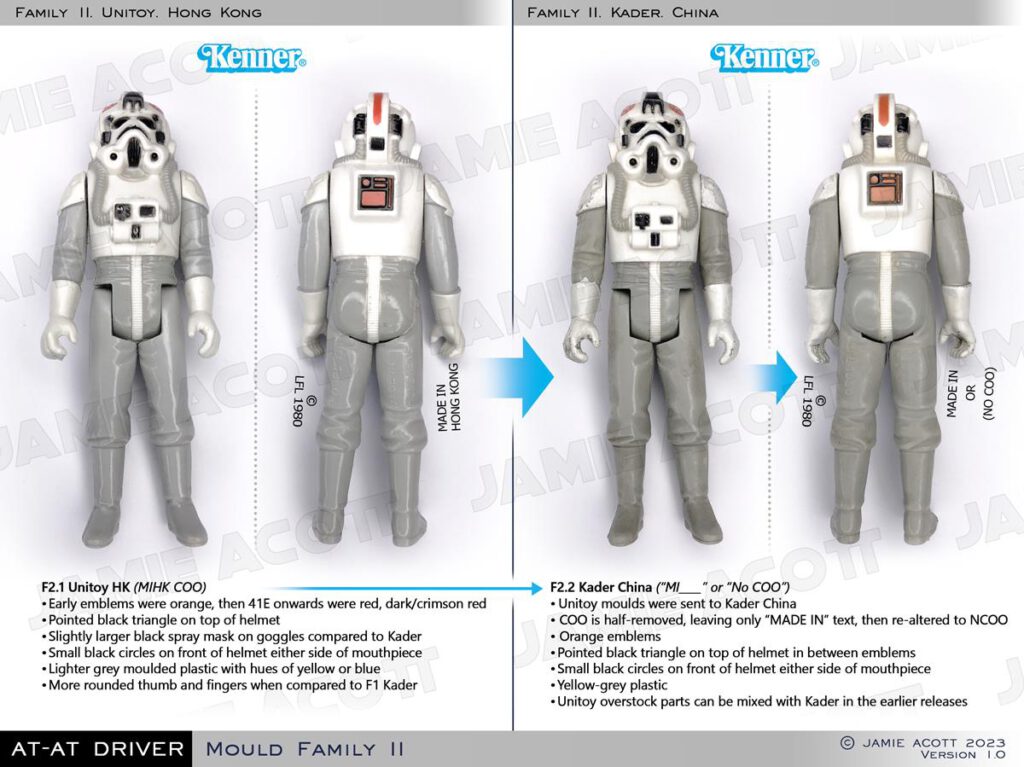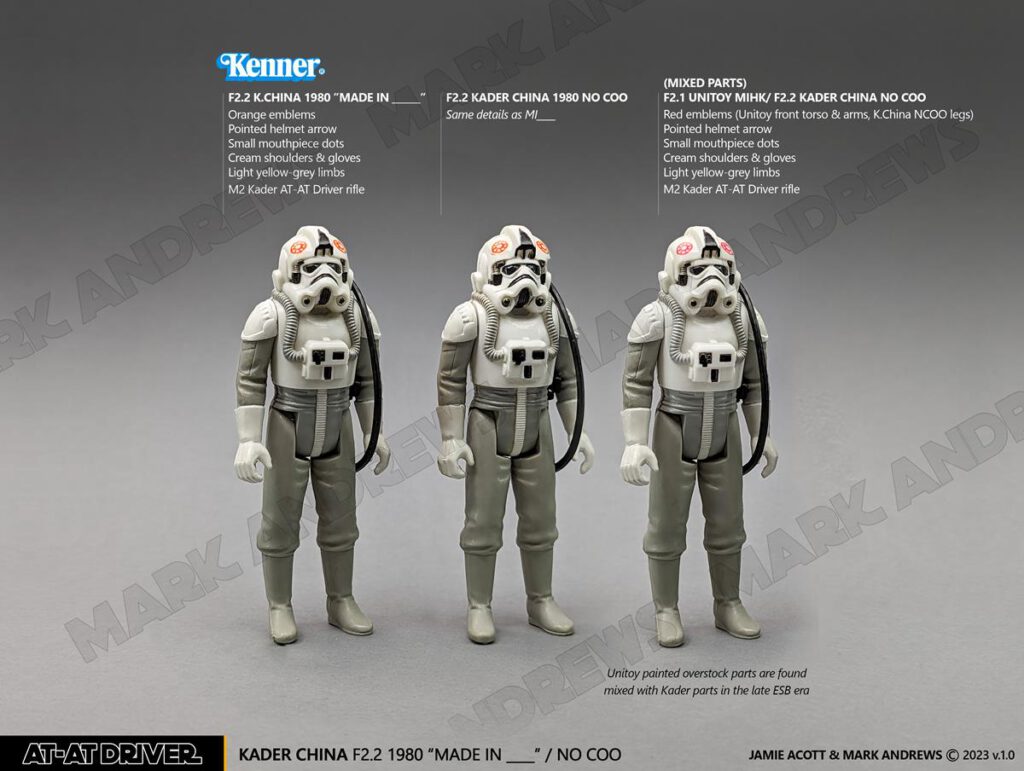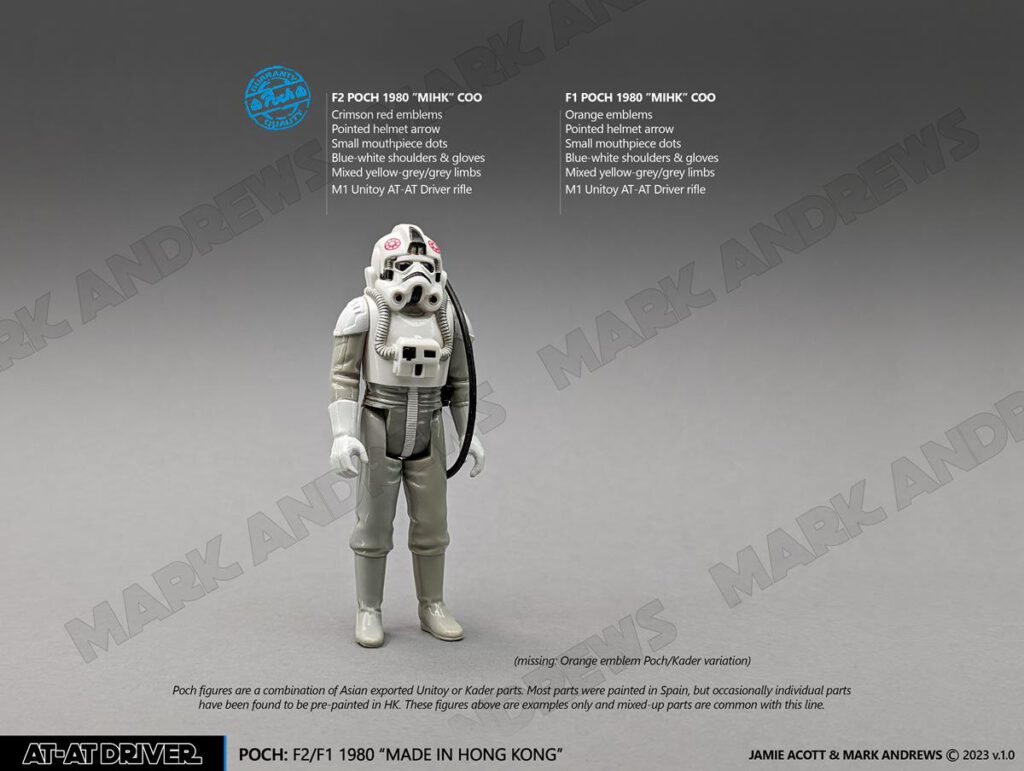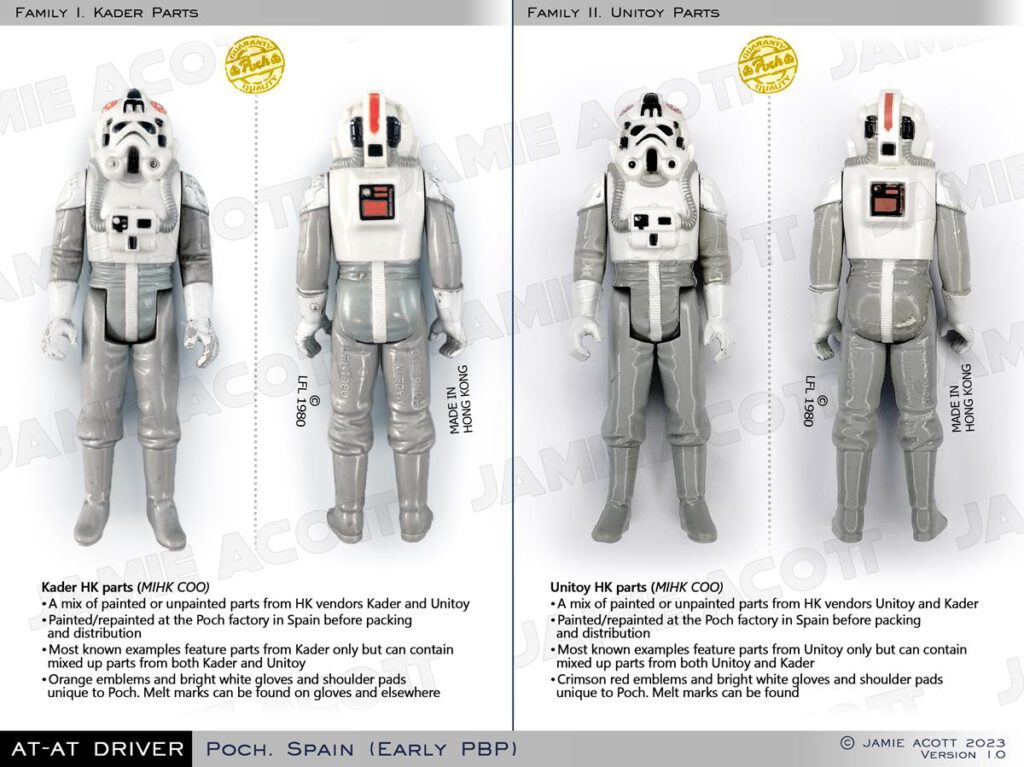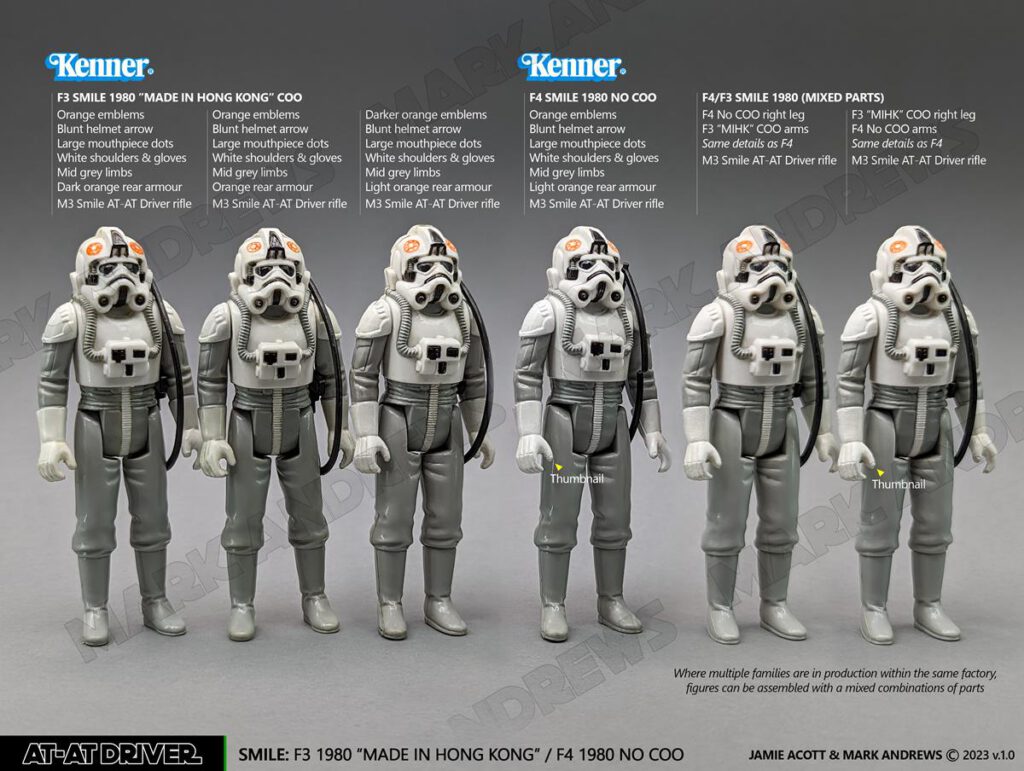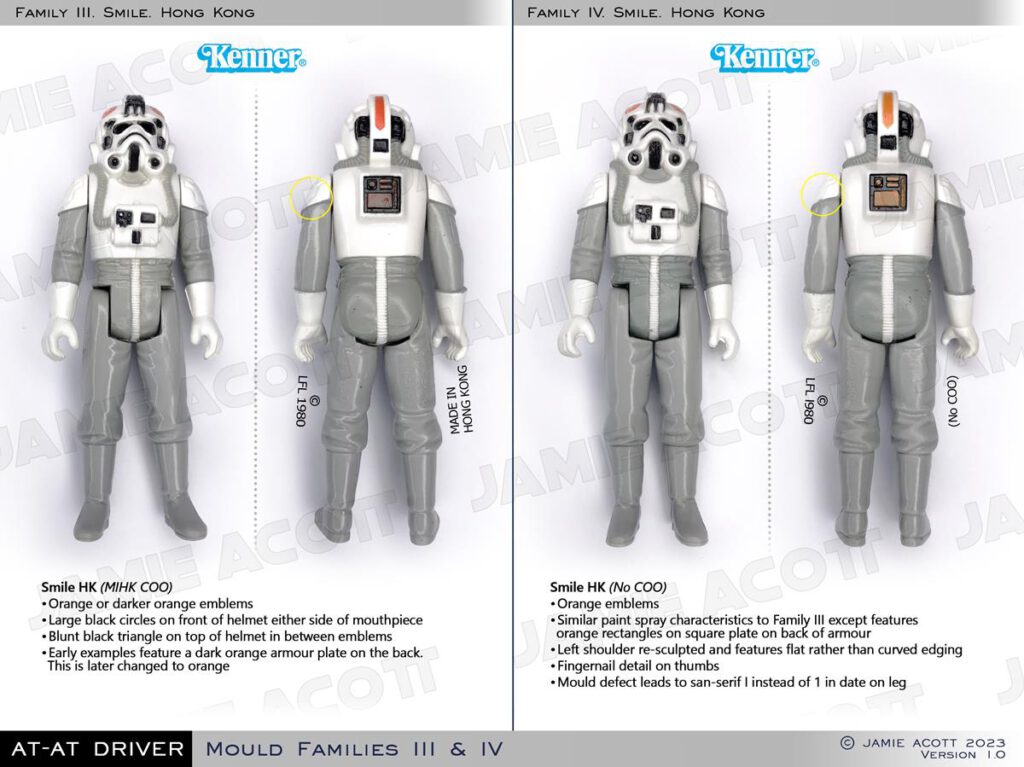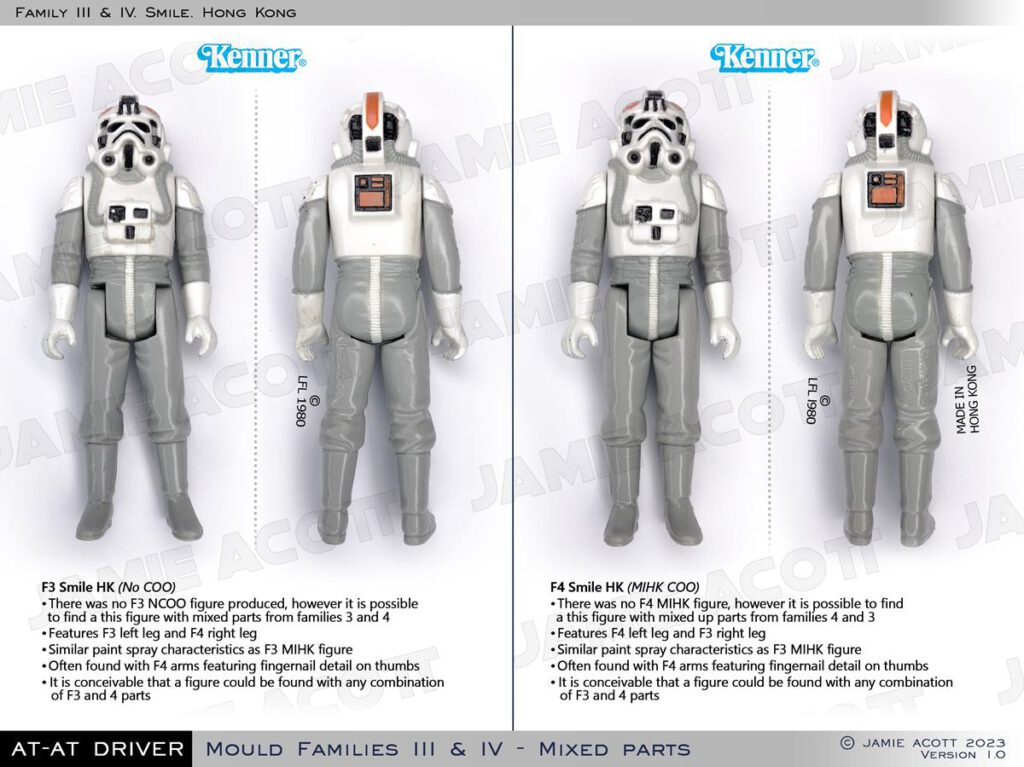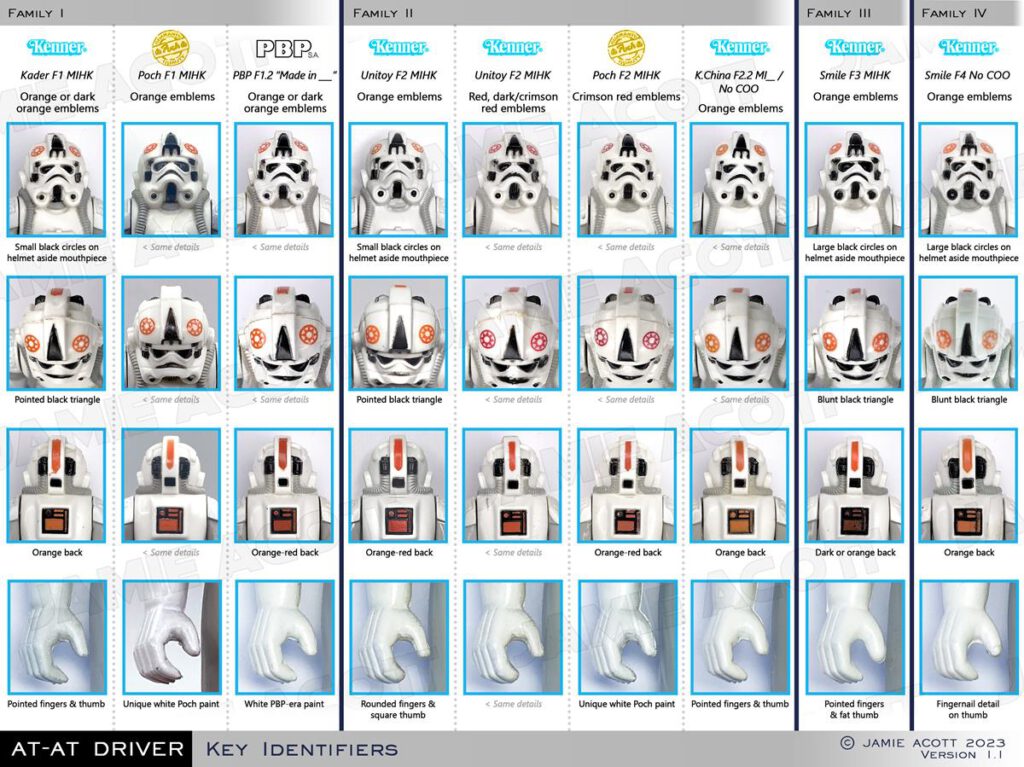AT-AT Driver

Chihuahua
TABLE OF CONTENTS
The reclassification of the COO sheet for the AT-AT Driver has been a challenging task. This is first and foremost because the differences between all four families are so minute. Secondly, the previous COO sheet and the mould classification on “The Mould Family Guide & Discussion Thread” was missing an entry, as two of the factories (Kader and Unitoy) had been grouped together in one mould family, and in addition there were actually two Smile families hiding in plain sight. Having collected a comprehensive catalogue of MOC examples over the last couple of years it has been finally possible to update the COO sheet with a degree of certainty. As with all Variant Villains’ undertakings there is a constant work in progress and the information here will be revised if new any evidence points to another conclusion.
KADER 1980 MADE IN HONG KONG
Above you can see following variants (left to right). Paint variations beyond what’s shown above are very likely.
- Orange emblems with blueish-white shoulders & gloves
- Dark orange emblems with creamy-white shoulders & gloves
- Red/Pinkish-red emblems. Kader/Unitoy mixed parts
Pinkish-red (faded?) Unitoy emblems with a Kader MIHK COO on the leg. Following the KEY IDENTIFIERS guide below, you can see this figure has the Unitoy shaped hands. The front and rear torsos are shot in different plastics. Figure has the Kader style bluish-white shoulders and gloves.
F1 KADER The Kader and Unitoy figures are extremely similar in appearance. Kader AT-AT Driver is characterised by orange emblems, small black circles either side of the mouthpiece, as well as a pointed black triangle on top of the helmet in-between the emblems.
Kader are moulded in a mid grey plastic when compared to Unitoy. However, it is worth mentioning that this plastic is prone to fading to a yellow grey, and can be confused with the lighter Unitoy plastic colour. Kader also has a thin pointed right fingers and thumb, whereas Unitoy have more rounded thumb and fingers. Ultimately, the safest way to differentiate between Kader and Unitoy is to look at the Country of Origin. There is no gap between HONG and KONG in the COO and this will categorically help you to distinguish between the two factories.
During the late ESB era, painted and unpainted overstock Unitoy parts were moved to both Spanish Poch/PBP and the Kader China factories. This resulted in figures from this short window were produced with a mix of Kader China and Unitoy factories, resulting in AT-AT Driver figures with Kader orange or Unitoy red emblems. (See also Kader China F2.2).
PBP 1980 MADE IN ____
Above you can see following variants (left to right):
- Orange emblems and white shoulders/gloves
- Dark orange emblems and creamy-white shoulders/gloves
- Dark orange emblems and white shoulders/gloves
Kader half-altered the country of origin to create the “MADE IN __” COO prior to sending the tools to PBP in Spain.
PBP’s version has the typical hard plastic with a higher level of surface detail on the torso. The limbs can be hard, soft plastic or even a combination of both on the same figure. PBP AT-AT Drivers have a tendency to feature messy paint and are found with either orange or dark-orange emblems.
The PBP figure should not be confused with the F2-R2a COO “MADE IN __” Kader China figure, which is shot in soft plastic and features a different paint application.
As an aside, the paint stamp for the AT-AT Driver’s emblems was also used for PBP’s late era Tie-Fighter Pilot figure.
UNITOY 1980 MADE IN HONG KONG
Above you can see following variants (left to right). There will be paint and plastic variations beyond what’s shown above.
- Dark orange emblems with white shoulders & gloves
- Orange emblems with white shoulders & gloves
- Dark red emblems, cream shoulders/gloves and light yellow-grey limbs
- Dark red emblems, cream shoulders/gloves and grey limbs
- Red emblems, cream shoulders/gloves and light blue-grey limbs
- POCH: Crimson red emblems and blue-white shoulders/gloves (included for comparison)
Unitoy AT-AT Drivers are also characterised by small black circles on front of the helmet either side of the mouthpiece, as well as a pointed black triangle on top of the helmet in between the emblems. Unitoy are moulded in a lighter grey plastic compared to Kader. Unitoy have a thick, creamy-white paint on the gloves.
The right hand on the Unitoy figure has a more rounded thumb and fingers. The Kader figure on the other hand has a thin pointed right hand. The best way to differentiate between the Unitoy figure and their Kader counterpart is to look at the Country of Origin. There is a gap between HONG and KONG in the COOs.
The Unitoy AT-AT Driver debuted on the 41A card and carried through to the 41C card with orange emblems. By the time the figure appeared on the 41E, the emblems had transitioned to red/dark red/crimson red, and this continued throughout the ESB line up to, and including the 48C.
Over time, the legs cavity developed some minor pitting, with gradually increasing “bumps” appearing on rear of the legs. The same type of pitting can also be found on the Boba Fett F3 leg tooling and the Kader wide handle Bespin blaster. There was no attempt to repair the leg cavities and the tool continued to be used until the very end of the production run.
KADER CHINA 1980 MADE IN ____ / No COO
Above you can see following variants (left to right). There will be paint and plastic variations beyond what’s shown above.
- Orange emblems (MI__ COO)
- Orange emblems (MIHK COO)
- Red emblems – Kader/Unitoy mixed parts
Red Unitoy emblem front torso with a Kader MIHK COO on the leg. Following the KEY IDENTIFIERS guide below, you can see this figure has the Unitoy shaped hands, but paint matches the Kader colour and application.
The F2 Unitoy tooling was sent to Kader China after the Unitoy ESB 48C around the same time the original F1 Kader moulds were sent to PBP. This AT-AT Driver type first appears on the ROTJ 48a2 cards.
Kader altered the first F2 leg cavity into a “MADE IN__” COO and the second cavity to remove the MIHK stamp altogether. The presence of the raised bumps on back of the legs help us to match these late Kader produced figures back to the earlier F2 Unitoy moulds.
At first glance the MI__ figure is often mistaken for the PBP figure but of course this Kader made figure is shot in softer plastic, instead of the harder plastic composition used by PBP. The fact the mould cavity (F2-R2aa) was half altered must have been in error, as the “MADE IN” text was also removed shortly thereafter (F2-R2ab).
We should note that during the late ESB era, painted Unitoy parts were distributed between Kader HK and the Poch/PBP factories in Spain. This meant that figures in the early period of China production were assembled from a mix of parts from Kader HK, Unitoy or Kader China factories. Once the stockpile of overstock HK parts was used up, the Kader China figure became more homogeneous.
The No COO AT-AT Driver with orange emblems becomes the typical Kader China produced figure going forward.
POCH 1980 MADE IN HONG KONG
Above you can see following variants (left to right). There will be paint and plastic variations beyond what’s shown above.
- Crimson red emblems
- Orange emblems (to be added)
Poch figures are made with a mix of painted and unpainted parts from both the Kader and Unitoy factories. The parts were painted (or repainted) and assembled in Spain during the early PBP era known as “Poch”.
The two common Poch variations are one with orange emblems made from Kader factory parts, and another with purple-red emblems made from Unitoy factory parts. Refer to the Key Identifiers graphic below. Most examples feature parts solely from the Kader factory, or solely from the Unitoy factory. But examples have been found with mixed up limbs, though experience suggests less frequently than other Poch figures.
Identifying Poch figures can be difficult. The most important element to note is the messily applied Poch paint, particularly the bright white paint on the shoulders and gloves. Poch expert Javier Ruilópez describes the emblems on the Unitoy variant as as an “Alizarin” crimson, which has a stronger purple hue than their Unitoy Kenner counterpart. Sometimes, though not always, melt marks can be found on the gloves and elsewhere across the figure. Weak sonic welding is another possible tell for figures produced at this factory.
SMILE 1980 MADE IN HONG KONG/ No COO/ Mixed parts
Above you can see following variants (left to right).
- Orange emblems with orange rear armour (MIHK COO)
- Orange emblems with orange rear armour (MIHK COO)
- Darker orange emblems with light orange rear armour (MIHK COO)
- Orange emblems with light orange rear armour (No COO)
- Mixed parts. F4 right leg, F3 arms. Same details as F4 figure.
- Mixed parts. F3 right leg, F4 arms. Same details as F4 figure.
In understanding the Smile factory variants, it is first worth noting that there are two different mould families for Smile. Family 3 was the first Smile figure produced, running throughout the ESB era. Smile only produced a MADE IN HONG KONG variant of this figure.
SMILE F3 MIHK: This version of the AT-AT Driver is characterised by large black circles on the front of the helmet, either side of the mouthpiece, as well as a blunt black triangle on top of the helmet in between the emblems. This differs from Kader and Unitoy and helps to differentiate the figure from the front. This figure also has a more rounded right hand with fat thumb. In addition, the earliest iterations feature dark rectangles on the square plate on the back of the armour, although these were later superseded by a version with orange rectangles.
It is worth noting that there is a Smile variant that has smaller black circles on the front and a pointy triangle on the top of the helmet. This can be found on the earlier Smile card backs from the 41A. However, on the 41E it began to transition to the more commonly found large black circle variant.
SMILE F4 NCOO: For whatever reason, during the ROTJ era Smile produced a new mould which we’ve classified as family 4. There was never a Hong Kong variant of this figure, only a No COO figure. This new family can be identified by the fingernail details located on both thumbs. Additionally the left shoulder varies slightly, featuring a flat, rather than curved edging. There is a defect on the moulding on the COO that leads to a san serif “I” instead of a “1” in the date “LFL I980”.
As mentioned there is no Smile family 3 No COO figure, or a Smile family 4 Hong Kong figure. However it is possible to find both these figures with mixed up parts from both families 3 & 4. The family 3 No COO figures have a family 3 left leg, and a family 4 right leg. Family 4 Hong Kong figures have a family 4 left leg, and a family 3 right leg. It’s a hard to find combination, but it is conceivable that a figure could be found with any combination of family 3 and 4 parts. This also applies to other characters which have multiple mould families produced within the same factory in the same time period.
